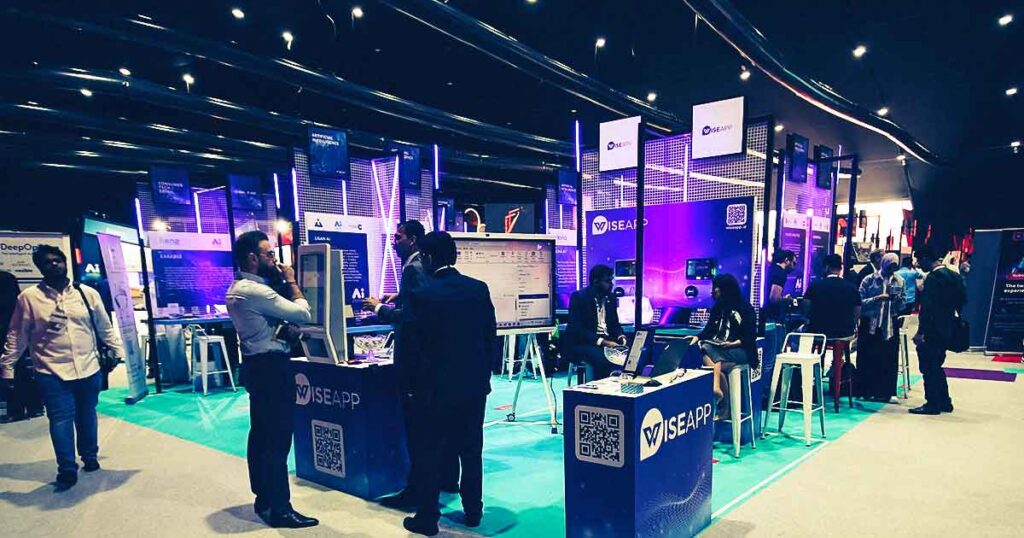Are Trade Shows Worth It for B2B Marketing?

Are Trade Shows Worth It for B2B businesses in today’s rapidly changing digital landscape? Traditionally, trade shows have been the bedrock of B2B marketing, providing a vibrant space for showcasing products, networking, and building meaningful partnerships. These events have been key to driving sales, boosting brand awareness, and conducting invaluable market research through direct engagement and live demos.
However, with the surge of online events, the question arises; will trade shows continue to hold value in 2024? The marketing landscape stands at a crossroads between traditional physical gatherings and virtual engagements. The time has come to ponder; do trade shows remain a viable investment for B2B enterprises amidst this evolving digital age?
The Evolving Landscape of Trade Shows

Forget the old booth and brochure days – trade shows are going digital to match our love of technology and remote work.
This new “hybrid” approach lets people join in person or virtually, offering the best of both worlds. Want the personal touch? Show up! Prefer something more convenient? Join online!
For attendees, it’s a treasure chest of knowledge, networking, and exploration, all without the travel hassle. For exhibitors, it’s a chance to reach a wider audience, both live and online. This win-win approach is flexible and reaches a broader spectrum of viewers, making it perfect for today’s business world.
Pros of Attending Trade Shows

Trade shows remain vital to B2B marketing strategies, offering substantial benefits that can influence a company’s trajectory. Here’s a breakdown of the core advantages:
| Market Research and Trendspotting | Trade shows serve as a live feed of industry innovations and emerging trends. They offer a unique vantage point to observe what competitors are focusing on and what might be the next big thing in your sector. Being seen and informed helps you stay ahead in a competitive market. |
| Lead Generation and Increased Brand Awareness | The visibility of trade shows is unparalleled. Your exhibiting places your brand in the spotlight, allowing you to attract and engage with potential leads already interested in your solutions. Direct engagement accelerates lead conversion and strengthens brand loyalty. |
| One-to-One Communication Opportunities | Engaging in direct dialogue with prospects, customers, and industry peers at trade shows is invaluable. These interactions often lead to immediate feedback, new project initiation, and sealing deals that might have taken months to finalize through other channels. The personal touch can clinch deals more effectively than the most polished email campaign. |

Understanding the Costs: Is the Investment Justifiable?
Considering the financial commitment involved in trade show participation, businesses must weigh the value of these events. The costs can be substantial, encompassing booth rental, design and setup, travel and accommodations for staff, marketing materials, and any additional fees for networking events or premium placement on the show floor.
However, when assessing the potential ROI, it’s essential to consider the immediate leads generated and the long-term brand exposure, industry positioning, and establishing key relationships. These benefits often translate into tangible business growth that can far outweigh the initial outlay.
To navigate the financial aspects of trade show exhibiting effectively, consider these tips:
- Early Planning
Secure early bird rates for booth space and accommodations to keep costs down.
- Budget Wisely
Allocate your budget across all necessary areas, including booth design, marketing, and personnel, ensuring that each dollar spent contributes to your overall goals.
- Leverage Digital Marketing
Complement your physical presence with a solid digital marketing campaign before, during, and after the event to maximize reach and engagement without significantly increasing costs.
Trade shows can be a goldmine for your business, but only if you strike the right balance. The key? Strategic marketing that blends traditional tactics with the digital world. By planning ahead, you can showcase your brand effectively and see real results. Think of it as a one-two punch for growth, attracting new customers and propelling your business forward.
Maximizing ROI from Trade Shows

Maximizing the ROI from trade shows requires a strategic approach encompassing meticulous planning, effective execution, and diligent follow-up. To ensure that your investment yields the best possible returns, here are key strategies to employ:
Start by setting clear, measurable objectives for your trade show participation. This could include the number of leads generated, deals closed, or increased brand awareness. Utilize tools and software to track these metrics, comparing them against the costs of exhibiting to gauge your success.
Capturing leads at trade shows is just the beginning. The real magic happens in the follow-up. Develop a streamlined process for contacting leads post-event, offering valuable information, or setting up meetings to keep the momentum going. Personalize your approach based on the interactions at the event to increase conversion rates.
Trade shows are prime networking opportunities. Engage with other exhibitors, attend seminars, and participate in networking events. These interactions can lead to valuable business development opportunities, collaborations, and insights into trade show trends and B2B marketing events.
Don’t overlook the power of virtual trade shows. They offer additional avenues to extend your reach, engage with a global audience, and capitalize on the trend toward digital interactions in the B2B space.
Businesses can significantly enhance their trade show ROI by focusing on these areas, making each event a powerful component of their marketing strategy.
The Rise of Virtual Trade Shows: A New Frontier
The rise of virtual trade shows represents a significant evolution in the B2B marketing landscape, blending traditional event dynamics with the boundless possibilities of digital technology. These online forums extend the reach of trade shows beyond physical venues, allowing businesses to engage with a global audience at a fraction of the cost of in-person events.

The benefits are clear: increased accessibility, lower overheads for organizers and participants, and the ability to capture and analyze attendee data in real-time. Yet, transitioning to a virtual format is not without its challenges.
The lack of face-to-face interaction can reduce the immediacy and impact of personal connections, a cornerstone of traditional trade show success. Furthermore, engaging participants through a screen demands high-quality content and innovative presentation techniques to replicate the vibrancy and energy of an on-site event.
Comparing audience reach and engagement, virtual trade shows undoubtedly offer broader accessibility, attracting participants who might have been unable to attend in person due to cost, distance, or time constraints. However, the depth of engagement can vary, with in-person events typically fostering more immediate and impactful connections.
Some examples highlight successful strategies for virtual trade shows, such as incorporating interactive elements like live polls, chat rooms, and virtual breakout sessions to foster engagement. A notable example includes a tech conference that achieved a 40% increase in participation by offering on-demand content access post-event, thus maximizing the longevity and impact of the trade show experience.
Moreover, while virtual trade shows carve out new audience engagement and operational efficiency frontiers, they also compel businesses to innovate continually to capture the human essence of in-person interactions in a digital format.
Cons of Attending Trade Shows and Mitigation Strategies
While trade shows offer valuable opportunities for B2B marketing, they also come with challenges, such as high costs, intense competition, and the complexity of lead qualification. The financial burden of securing booth space, designing and shipping displays, and covering travel expenses can be significant, particularly for smaller businesses.
Moreover, the crowded market at these events means that standing out from competitors requires extra creativity and effort. Additionally, not all leads gathered at trade shows are of equal value, making identifying and nurturing the most promising contacts a crucial yet challenging task.
To navigate these hurdles, businesses can adopt several strategies:
Focus on trade shows that align closely with your target market and business goals to ensure you’re investing resources in the most promising opportunities for ROI.
Invest in a booth that not only attracts attention but is also designed to facilitate meaningful conversations. Use interactive displays or live demonstrations to draw in attendees.
Build anticipation and awareness through targeted pre-event marketing campaigns. This can help attract more qualified leads to your booth.
Implement a more discerning approach to collecting leads, focusing on those who show genuine interest or need your products or services.
For broader reach and cost-effectiveness, complement your physical presence with participation in virtual trade shows. This approach can help mitigate costs while enabling you to connect with a broader audience.
By addressing these challenges with thoughtful strategies, businesses can enhance their trade show ROI, making the most of in-person and virtual B2B marketing events.
It’s clear that trade shows have not lost their luster in B2B marketing; instead, they’ve adapted and evolved. Whether through the traditional hustle and bustle of in-person gatherings or the digital corridors of virtual events, trade shows remain indispensable for comprehensive market research, generating high-quality leads, enhancing brand visibility, and opening doors to direct sales.
The advent of hybrid models marks a significant leap forward, merging the best of both worlds to extend the reach of these events beyond geographical limitations. This evolution broadens access to invaluable business development opportunities and democratizes participation in these critical industry forums.
Yet, the leap into trade show marketing cannot be made on a whim. Investing resources—both financial and human—demands a reasonable approach. Businesses are urged to meticulously assess the upfront costs, the competitive landscape, and how each trade show aligns with their overarching marketing objectives.
Achieving a solid return on investment from trade show participation hinges on a trifecta of strategic actions: selecting the most synergistic events, crafting compelling and engaging experiences for attendees, and instituting a robust follow-up process to nurture lead to lasting business connections.
Are trade shows worth it for B2B marketing in 2024?
The worthiness of trade shows is contingent upon a company’s ability to make informed selections, prepare meticulously for each event, and implement strategies that effectively exploit the unique networking and business opportunities trade shows provide.
When navigated with foresight and precision, trade shows can indeed be a powerhouse for B2B marketing success, driving growth and fostering industry connections that are both meaningful and profitable.
In their evolved state, trade shows offer unrivaled opportunities for market engagement and business growth within the B2B sector. The move towards hybrid formats has only heightened their value, making them more accessible and versatile.
Success in this arena requires a strategic blend of careful event selection, immersive attendee engagement, and diligent lead follow-up. With these elements in place, the investment in trade shows can yield substantial dividends, affirming their worthiness as a critical component of a comprehensive B2B marketing strategy in 2024 and beyond.

Key Takeaways
Trade shows have been pivotal in B2B marketing for fostering direct relationships, enhancing brand visibility, and conducting market research. With the digital era ushering in virtual trade shows, businesses now face the question of their continued value in 2024, prompting a reevaluation of trade show participation’s costs and benefits:
Evolving Landscape
The trade show scene is rapidly changing, with digital innovations leading to hybrid events combining in-person and virtual experiences. This transformation caters to a broader audience and offers new opportunities for exhibitors to showcase their solutions, significantly impacting trade show ROI.
Pros of Attending
Trade shows are invaluable for B2B marketing, offering unique advantages in market research, lead generation, and brand awareness. Direct interactions at these events can lead to immediate feedback and potential deals, highlighting the importance of personal engagement in achieving trade show success.
Understanding the Costs
While trade shows present significant investment opportunities, assessing their ROI involves considering both direct and indirect benefits. Strategic planning, wise budget allocation, and leveraging digital marketing are vital to justifying the costs and maximizing returns from trade show participation.
Maximizing ROI
To optimize trade show ROI, businesses should set clear objectives, focus on effective lead generation and follow-up, and embrace networking and virtual event components. These strategies enhance engagement and business development opportunities, making each trade show valuable to the marketing mix.
Virtual Trade Shows
Virtual trade shows have emerged as a cost-effective alternative to traditional events, offering extended reach and innovative engagement strategies. Despite challenges in replicating face-to-face interactions, successful virtual trade shows leverage interactive elements to maintain engagement and maximize event impact.
Cons and Mitigation Strategies
High costs, intense competition, and lead qualification complexities are notable trade show challenges. Strategic planning, engaging booth designs, targeted pre-event marketing, and a focus on quality lead generation and leveraging virtual opportunities can mitigate these issues and enhance overall trade show ROI.
Elevate Your Trade Show Impact with Blue Atlas Marketing!
Elevate Your Trade Show Marketing Strategy with Blue Atlas! Are you ready to scale your trade show strategy and captivate your industry audience? At Blue Atlas Marketing, we specialize in crafting unforgettable trade show experiences that drive engagement and results. Unlock the full potential of your events with our expert insights and innovative solutions.
Enhance your business growth and ensure you stand out by leveraging our trade show marketing services. Contact us today to begin your journey towards transforming your success at trade shows!






